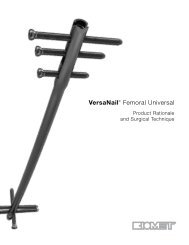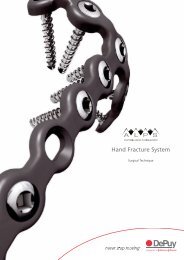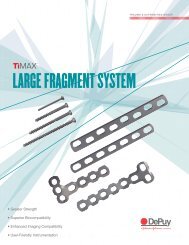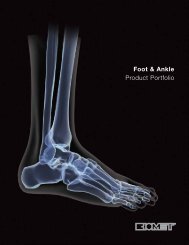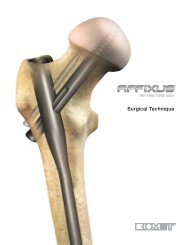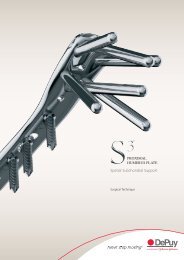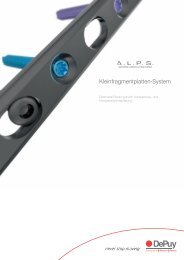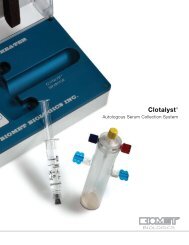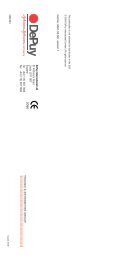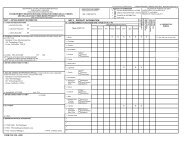DVR Anatomic Plate Surgeon Testimonials - Biomet
DVR Anatomic Plate Surgeon Testimonials - Biomet
DVR Anatomic Plate Surgeon Testimonials - Biomet
Create successful ePaper yourself
Turn your PDF publications into a flip-book with our unique Google optimized e-Paper software.
<strong>DVR</strong> ® <strong>Anatomic</strong> <strong>Plate</strong><br />
A 10 year landmark<br />
in clinical evidence<br />
<strong>Surgeon</strong> <strong>Testimonials</strong><br />
<strong>DVR</strong> Testimonial Brochure.PRINT.indd 1 10/5/10 10:42:30
JEROEN VAN HAECKE<br />
AZ Groeninge, Kortrijk, Belgium<br />
When I started in orthopaedics, the treatment of wrist fractures was limited with nothing<br />
more than k-wires and cast, and I believed that all wrist fractures eventually healed well. As<br />
I evolved in my training and developed a serious interest for hand surgery, wrist fractures<br />
became one of my favourite topics.<br />
Number of <strong>DVR</strong> ® <strong>Anatomic</strong> <strong>Plate</strong> cases<br />
180<br />
<strong>DVR</strong> user since<br />
2005<br />
Main benefits<br />
Ease of use, quick surgery<br />
Favourite features<br />
Fixed angle k-wire holes<br />
I saw that sometimes the more serious wrist fractures treated with a plate, screws and<br />
sometimes bone grafts were recovering better than the simple fractures treated with<br />
k-wires and cast. Also the mobility of the patient was better due to the better reduction<br />
and direct mobilisation.<br />
I experienced this same effect in every joint treated with a plate. This is when I started to<br />
look for a good plating system specifically designed for the wrist.<br />
Influenced by reading an article written by Orbay and Fernández reporting promising<br />
results with the <strong>DVR</strong> ® <strong>Anatomic</strong> <strong>Plate</strong>, I started to use the system in 2005 and since then<br />
I’ve placed over 180 <strong>DVR</strong> ® <strong>Anatomic</strong> <strong>Plate</strong>s.<br />
Palmar plating for wrist fractures has changed the total treatment plan. It started with an<br />
indication setting for open reduction and internal fixation and it now includes osteoporotic<br />
patients instead of just the high energy fractures.<br />
The operative plan has also changed; we now use the palmar approach making an incision<br />
over the course of the flexor carpi radialis and preserving the pronator quadrates. Holding<br />
the reduction is a great deal easier than before, allowing me to concentrate more on the<br />
fracture than on the fixation. By doing this my reduction becomes more anatomical.<br />
Subchondral support pegs used in osteoporotic patients made wrist fracture treatment in<br />
these patients easier, and now my results are better.<br />
Early mobilisation allows my elderly patients to start postoperative rehabilitation earlier and<br />
a faster return to normal activity allows them to remain independent.<br />
The <strong>DVR</strong> ® <strong>Anatomic</strong> <strong>Plate</strong> has a great design, is simple to use and very effective. The plate<br />
is a great help in reduction and a strong fixation tool. The surgeon still must have the<br />
knowledge to use it, therefore education remains important.<br />
1<br />
<strong>DVR</strong> Testimonial Brochure.PRINT.indd 1 10/5/10 10:42:31
ANDREW BARROW<br />
Sunninghill Hospital, Johannesburg, South Africa<br />
Since the <strong>DVR</strong> ® <strong>Anatomic</strong> <strong>Plate</strong> first became available in South Africa in 2003, I have had<br />
the pleasure and privilege of being able to treat in excess of 300 patients with this ground<br />
breaking device.<br />
In my opinion George Orbay should be commended for being the first person to appreciate<br />
the true shape of the volar distal radius in terms of surface area and fixation using a locked<br />
plate. The <strong>DVR</strong> ® <strong>Anatomic</strong> <strong>Plate</strong> was truly ground-breaking in my management of distal<br />
radius fractures and since the inception of its use, I have now become more and more<br />
confident in strongly advocating volar radial fixation for almost all distal radial fractures.<br />
I think the <strong>DVR</strong> ® <strong>Anatomic</strong> <strong>Plate</strong> by virtue of its shape is the most anatomically suited plate<br />
on the market for restitution of normal anatomy.<br />
The <strong>DVR</strong> ® <strong>Anatomic</strong> <strong>Plate</strong> instrumentation, distal screws and overall user-friendliness of the<br />
entire system, make this radial plate a pleasure to use. The <strong>DVR</strong> ® <strong>Anatomic</strong> <strong>Plate</strong> enables<br />
patients to restore movement, rapidly regain function and return to normal ADL’s and work<br />
far sooner than any previous method used for treating distal radius fractures.<br />
It is with absolutely no bias, and no financial interest, that I can whole heartedly endorse a<br />
fantastic plating system. In my practice the <strong>DVR</strong> ® <strong>Anatomic</strong> <strong>Plate</strong> certainly has changed the<br />
life positively of many, many patients.<br />
Number of <strong>DVR</strong> ® <strong>Anatomic</strong> <strong>Plate</strong> cases<br />
Over 300<br />
<strong>DVR</strong> user since<br />
2003<br />
Main benefits<br />
Ease of use, user friendly<br />
Favourite features<br />
<strong>Anatomic</strong>al design<br />
2<br />
<strong>DVR</strong> Testimonial Brochure.PRINT.indd 2 10/5/10 10:42:32
MICHELE RAMPOLDI<br />
CTO Hospital, Rome, Italy<br />
I began to use the <strong>DVR</strong> ® <strong>Anatomic</strong> <strong>Plate</strong> system in 2006.<br />
Number of <strong>DVR</strong> ® <strong>Anatomic</strong> <strong>Plate</strong> cases<br />
120<br />
<strong>DVR</strong> user since<br />
2006<br />
Main benefits<br />
Ease of use<br />
For me, one of the main features of the <strong>DVR</strong> ® <strong>Anatomic</strong> <strong>Plate</strong> is the anatomical shape<br />
and the thin distal end contour that fits onto the watershed line. The orientation of the<br />
fixed angle distal screws and the different plate size options is another great benefit of the<br />
<strong>DVR</strong> ® <strong>Anatomic</strong> <strong>Plate</strong>. There is a variety of plate lengths and widths providing flexibility<br />
depending on the anatomy of my patient.<br />
I find the <strong>DVR</strong> ® <strong>Anatomic</strong> <strong>Plate</strong> easy to apply on the radial surface. It allows me to<br />
achieve good anatomical restoration and subchondral support due to the double row of<br />
distal screws.<br />
The k-wire holes allow a temporary fixation of the plate to predict the exact positioning of<br />
the pegs and the F.A.S.T. Guide inserts allow for an easy drilling of the distal screws.<br />
With the <strong>DVR</strong> ® <strong>Anatomic</strong> <strong>Plate</strong> my patients get stability, minimal interference with<br />
surrounding soft tissues and early functional recovery.<br />
Favourite features<br />
<strong>Anatomic</strong>al shape, k-wires and F.A.S.T. Guide inserts<br />
3<br />
<strong>DVR</strong> Testimonial Brochure.PRINT.indd 3 10/5/10 10:42:33
DIEGO FERNÁNDEZ<br />
Lindenhofspital, Bern, Switzerland<br />
I started to use the <strong>DVR</strong> ® <strong>Anatomic</strong> <strong>Plate</strong> when I received the first prototypes from<br />
Dr. Orbay, between 1998 and 1999.<br />
The <strong>DVR</strong> ® <strong>Anatomic</strong> <strong>Plate</strong> allows provisional fixation of the implant with the use of<br />
k-wires thus permitting optimal plate positioning. F.A.S.T. Guide inserts allow for an<br />
easy drilling of the fixed angle pegs without the need of attaching a drill guide manually<br />
for each hole, which could be time consuming.<br />
I really like the spatial fan shaped distribution of the pegs which follow the anatomy of the<br />
subchondral plate, providing the ideal buttress for osteoporotic bone and intra-articular<br />
fragments. If the plate is perfectly positioned restoration of normal distal radius anatomy is<br />
easy to achieve.<br />
I keep using the <strong>DVR</strong> ® <strong>Anatomic</strong> <strong>Plate</strong> because of the easiness of handling, design and<br />
instrumentation.<br />
The <strong>DVR</strong> ® <strong>Anatomic</strong> <strong>Plate</strong> enables patients to have a cast free after treatment, early<br />
motion and return to work (2-3 weeks for light manual activities, 6-8 weeks for high wrist<br />
demand). I think it is an ideal method of treatment for independent elderly individuals with<br />
osteoporosis.<br />
Number of <strong>DVR</strong> ® <strong>Anatomic</strong> <strong>Plate</strong> cases<br />
Over 120<br />
<strong>DVR</strong> user since<br />
1998<br />
Main benefits<br />
Ease of use<br />
Favourite features<br />
K-wires, F.A.S.T. Guide inserts, subchondral support<br />
4<br />
<strong>DVR</strong> Testimonial Brochure.PRINT.indd 4 10/5/10 10:42:33
MIGUEL TRIGUEIROS<br />
Hospital Geral de Santo António, Portugal<br />
My first contact with the <strong>DVR</strong> ® <strong>Anatomic</strong> <strong>Plate</strong> was through a scientific paper in 2002,<br />
written by Jorge Orbay. At that time, the plate was presented as the solution for all<br />
problems related to distal radius fractures, such as reductions with unstable fixations,<br />
long period of immobilisation, high rates of infection, especially when using conservative<br />
treatments with k- wires, reflex sympathetic dystrophy syndromes.<br />
Number of <strong>DVR</strong> ® <strong>Anatomic</strong> <strong>Plate</strong> cases<br />
Over 200<br />
<strong>DVR</strong> user since<br />
2005<br />
Main benefits<br />
Immediate mobilisation, simple procedure<br />
Favourite features<br />
<strong>Anatomic</strong> design<br />
For the first time in 2004, I was able to use the volar approach in the treatment of distal<br />
radius fractures, with an anatomic plate and locking screws.<br />
My first case with the <strong>DVR</strong> ® <strong>Anatomic</strong> <strong>Plate</strong> was a 60 year old woman, active, mother of a<br />
fellow surgeon, with a type III (Fernandez/Júpiter) fracture. She had been previously treated<br />
with k-wires but with poor outcome. The plate was implanted three weeks after the initial<br />
trauma and the outcome was no post-op immobilisation, high degree of function and<br />
mobility at the four week post-op.<br />
This experience was the turning point for me as it finally confirmed the perceptions that I<br />
had since 2002. The standard treatment for unstable distal radius fractures should be with<br />
a plate implanted through a volar approach. Since then I have been treating an average of<br />
6 cases per month.<br />
My approach to distal radius fractures can be summed up in two clear points; First, classify<br />
the fracture according to the Fernandez/Jupiter classification. Second, verify the fracture<br />
stability: a) If stable – cast for 5 weeks; b) If unstable – OOS plating via volar approach<br />
The volar approach allows manipulation and fragment stabilisation, not only by the locking<br />
screws but also through the plate’s anatomical design. The plate’s contour also avoids<br />
flexors tendons interference.<br />
The stability achieved allows immediate mobilisation, with function and mobility recovery<br />
within an average of three weeks.<br />
The complication rate is very low; with the most common complication due to<br />
intra-articular screw placement, typically due to lack of experience from the surgeon. This<br />
technique is fairly simple, with a short learning curve, and should be considered as a must<br />
do for basic training for registrars (or junior Orthopaedic surgeons).<br />
The <strong>DVR</strong> ® <strong>Anatomic</strong> <strong>Plate</strong> has provided a big change in the treatment of articular and non<br />
articular distal radius fractures, and has decreased substantially the morbidity rate, social<br />
costs and other cost related to sickness leaves periods.<br />
From the patient point of view what was previously considered as a dramatic and<br />
incapacitating occurrence, is now understood as a problem with an “easy” solution.<br />
5<br />
<strong>DVR</strong> Testimonial Brochure.PRINT.indd 5 10/5/10 10:42:35
MIGUEL DEL CERRO<br />
Hospital Gregorio Marañón, Madrid, Spain<br />
I have surgically treated over 500 cases of distal radius fractures. Early treatment consisted<br />
of using external fixators, k-wires and conventional plating systems. Four years ago I started<br />
to use the <strong>DVR</strong> ® <strong>Anatomic</strong> <strong>Plate</strong> and to date I have implanted over 200 <strong>DVR</strong> ® <strong>Anatomic</strong><br />
<strong>Plate</strong>s for treating distal radius fractures and osteotomies.<br />
The main benefit of this fixed angle implant combined with a divergent distal fixation<br />
pattern is that it allows for an early mobilisation of the wrist. Other available systems<br />
require a longer immobilisation period which causes mobility limitations and a longer<br />
postoperative rehabilitation. Very rarely have we achieved a normal mobilisation of a distal<br />
radius fracture treated with conventional systems. With the <strong>DVR</strong> ® <strong>Anatomic</strong> <strong>Plate</strong> the<br />
number of patients that have achieved a complete range of motion is highly significant.<br />
The learning curve with the <strong>DVR</strong> ® <strong>Anatomic</strong> <strong>Plate</strong> is a great deal shorter because the<br />
anatomical shape of the plate acts as a template when reducing the fracture. Once the<br />
fracture is reduced, the stability is given by the different divergent locking pegs and screws.<br />
These screws are placed easily with the use of the F.A.S.T. Guide inserts and once the<br />
distal screws are put in place the fixation given is very stable and secure.<br />
I believe Orbay’s anatomical studies on the surgical approach and reduction with a<br />
tenotomy of the brachioradialis have facilitated even more this procedure.<br />
The <strong>DVR</strong> ® <strong>Anatomic</strong> <strong>Plate</strong> allows an easy restoration of the distal radius anatomy. Without<br />
doubt, the surgeon should bring his experience in treating this type of fractures through<br />
adequate surgical manoeuvres. The plate helps but it is very important the surgeons have<br />
the know-how.<br />
Number of <strong>DVR</strong> ® <strong>Anatomic</strong> <strong>Plate</strong> cases<br />
Over 200<br />
<strong>DVR</strong> user since<br />
2006<br />
Main benefits<br />
Ease of use<br />
Favourite features<br />
Subchondral support pegs<br />
6<br />
<strong>DVR</strong> Testimonial Brochure.PRINT.indd 6 10/5/10 10:42:36
THOR HALSE<br />
Capio St Görans Hospital, Stockholm, Sweden<br />
I have been using the <strong>DVR</strong> ® <strong>Anatomic</strong> <strong>Plate</strong> since it was introduced to Capio St Görans<br />
Hospital, Stockholm in 2007. We were the first hospital in a Nordic country to receive the<br />
distal radius system.<br />
Number of <strong>DVR</strong> ® <strong>Anatomic</strong> <strong>Plate</strong> cases<br />
100<br />
<strong>DVR</strong> user since<br />
2007<br />
Main benefits<br />
Ease of use, quick surgery<br />
Favourite features<br />
K-wires and F.A.S.T. Guide inserts<br />
The shape of the <strong>DVR</strong> ® <strong>Anatomic</strong> <strong>Plate</strong> and cradle of the three-dimensional pegs form helps<br />
me to recreate the anatomy from a volar approach. It works well for the most distal as well<br />
as severely comminuted fractures.<br />
For me, the main benefits of the <strong>DVR</strong> ® <strong>Anatomic</strong> <strong>Plate</strong> are the ease of use and the ability<br />
to perform quick surgery. The possibility to fixate the <strong>DVR</strong> ® <strong>Anatomic</strong> <strong>Plate</strong> temporarily<br />
to radius by using k-wires makes it easier to optimise the position of the plate to achieve<br />
anatomic reduction of the fracture. Once the k-wires are in place the procedure is really<br />
fast and the pegs and screws are easy to implant. Finally, the F.A.S.T. Guide inserts<br />
enhance my visualisation of the screw trajectories, thus making the it really easy and fast to<br />
do the drilling and measuring.<br />
The key to the procedure for me is the predefined screw trajectories that help me build<br />
a strong subchondral support to restore the natural anatomy. The different widths of the<br />
plate also give me the flexibility to recreate and maintain the natural anatomy. For example,<br />
using a wider <strong>DVR</strong> ® <strong>Anatomic</strong> <strong>Plate</strong> to obtain a stabilisation under the critical lunate fossa<br />
in a die-punch fracture as well as getting a good stabilisation of the radial styloid.<br />
Both my colleagues and I agree there have been great improvements in our patient’s<br />
outcome with the ability to quickly return to a normal life after a severe distal radius<br />
fracture compared to when we did not use the <strong>DVR</strong> ® <strong>Anatomic</strong> <strong>Plate</strong>.<br />
7<br />
<strong>DVR</strong> Testimonial Brochure.PRINT.indd 7 10/5/10 10:42:37
NIKOLAI SPRANGER<br />
Unfallkrankenhaus Berlin, Germany<br />
I started to use the <strong>DVR</strong> ® <strong>Anatomic</strong> <strong>Plate</strong> in 2006.<br />
What I like most of the <strong>DVR</strong> ® <strong>Anatomic</strong> <strong>Plate</strong> is that it is simple and easy to use. With the<br />
<strong>DVR</strong> ® <strong>Anatomic</strong> <strong>Plate</strong> you may treat almost every fracture of the distal forearm. The <strong>DVR</strong> ®<br />
<strong>Anatomic</strong> <strong>Plate</strong> helps reduce the OR time and the X-Ray exposure.<br />
The <strong>DVR</strong> ® <strong>Anatomic</strong> <strong>Plate</strong> has an anatomic design that matches the watershed line. It is a<br />
simple, self-explanatory system which avoids screw-displacement.<br />
I think the <strong>DVR</strong> ® <strong>Anatomic</strong> <strong>Plate</strong> is a reliable and stable implant that helps the surgeon<br />
achieve excellent results for the treatment of distal radius fractures and reduces possible<br />
complications for the patient in further treatment.<br />
Number of <strong>DVR</strong> ® <strong>Anatomic</strong> <strong>Plate</strong> cases<br />
Over 50<br />
<strong>DVR</strong> user since<br />
2006<br />
Main benefits<br />
Ease of use<br />
Favourite features<br />
<strong>Anatomic</strong> design<br />
8<br />
<strong>DVR</strong> Testimonial Brochure.PRINT.indd 8 10/5/10 10:42:37
AMAL KHOURY<br />
Hadassah Medical Center, Jerusalem, Israel<br />
Five years of experience and above 400 satisfied patients reassure my trust in the <strong>DVR</strong> ®<br />
<strong>Anatomic</strong> <strong>Plate</strong> almost on a daily basis. With its minimum number of tools and plates, and<br />
various fixation options the <strong>DVR</strong> ® <strong>Anatomic</strong> <strong>Plate</strong> wins both the simplicity and the variability<br />
games at once.<br />
Number of <strong>DVR</strong> ® <strong>Anatomic</strong> <strong>Plate</strong> cases<br />
Over 400<br />
The <strong>DVR</strong> ® <strong>Anatomic</strong> <strong>Plate</strong>’s asymmetric anatomic design allows me to get as close as<br />
possible to the natural anatomic structure of the joint, with maximum support and minimal<br />
chances for soft tissue irritation. In terms of fracture reduction, fixation, motion restoration<br />
and rehabilitation time, the <strong>DVR</strong> ® <strong>Anatomic</strong> <strong>Plate</strong> is an excellent choice.<br />
<strong>DVR</strong> user since<br />
2005<br />
Main benefits<br />
Simplicity<br />
Favourite features<br />
<strong>Anatomic</strong> design<br />
9<br />
<strong>DVR</strong> Testimonial Brochure.PRINT.indd 9 10/5/10 10:42:39
JAMES WARNER<br />
Royal Bolton Hospital, Bolton, UK<br />
I began to use the <strong>DVR</strong> ® <strong>Anatomic</strong> <strong>Plate</strong> in February 2005 when it was first launched<br />
by Hand Innovations in the UK. I had followed Dr Orbay’s work in the literature and<br />
was keen to start using the plate as soon as it became available in the UK. I now have<br />
personal experience of approximately 250 <strong>DVR</strong> ® <strong>Anatomic</strong> <strong>Plate</strong> cases. In our hospital<br />
we fix approximately 250 wrists per year with this plate and have been very pleased with<br />
our outcomes.<br />
I feel that the <strong>DVR</strong> ® <strong>Anatomic</strong> <strong>Plate</strong> is very well designed and relatively simple to use. The<br />
plates fit the shape of the distal radius well, allowing the fracture to be moulded to the<br />
plate - using it as a template. The fact that the plate is designed to sit up to the watershed<br />
line means that the volar marginal fragment is usually nicely supported and yet the plate<br />
remains within the concavity of the volar aspect of the distal radius. Hence flexor tendon<br />
irritation should not be a problem with a well positioned implant.<br />
The k-wire holes in the proximal row not only provide a temporary hold of the fracture<br />
position, but also allow accurate positioning of the plate to ensure correct distal peg/<br />
screw placement. The risk of inadvertent placement of a distal peg into the joint is<br />
therefore minimized. At the same time the surgeon can be confident that the fixed<br />
angle of the distal pegs/screws will ensure good support of the subchondral bone in the<br />
distal fragment.<br />
The F.A.S.T. Guide inserts are simple to use and don’t obscure the view of the distal<br />
fragments. It is therefore possible to manipulate the radial styloid fragment after fixation of<br />
the lunate fossa fragments in more complex displaced intra-articular fractures.<br />
Number of <strong>DVR</strong> ® <strong>Anatomic</strong> <strong>Plate</strong> cases<br />
Over 250<br />
<strong>DVR</strong> user since<br />
2005<br />
Main benefits<br />
Immediate mobilisation<br />
Favourite features<br />
<strong>Anatomic</strong> design, k-wires, FAST guides<br />
We have not needed to immobilise the wrist post surgery allowing earlier restoration<br />
of function and return to activities of daily living. Our patients have found this a<br />
definite benefit.<br />
Along with use of the extended FCR approach (as described by Dr Orbay), I have found that<br />
this plating system allows me to treat all but a very few acute fractures and malunions of<br />
the distal radius from the volar aspect and in a reproducible way. We have been able to<br />
achieve consistently good results at our hospital using the <strong>DVR</strong> ® <strong>Anatomic</strong> <strong>Plate</strong> in the<br />
management of both intra-articular and extra-articular fractures of the distal radius.<br />
10<br />
<strong>DVR</strong> Testimonial Brochure.PRINT.indd 10 10/5/10 10:42:39
This publication is not intended for distribution in the USA.<br />
Never Stop Moving is a trademark of DePuy International Limited.<br />
<strong>DVR</strong> ® <strong>Anatomic</strong> <strong>Plate</strong> is a registered trademark and F.A.S.T. Guide is a trademark of DePuy Orthopaedics, Inc.<br />
© 2010 DePuy International Limited. All rights reserved.<br />
Registered in England No. 3319712<br />
Cat No: 0612-21-000 version 1<br />
DePuy International Ltd<br />
St Anthony’s Road<br />
Leeds LS11 8DT<br />
England<br />
Tel: +44 (0)113 387 7800<br />
Fax: +44 (0)113 387 7890<br />
0086<br />
Issued: 05/10<br />
<strong>DVR</strong> Testimonial Brochure.PRINT.indd 11 10/5/10 10:42:39




